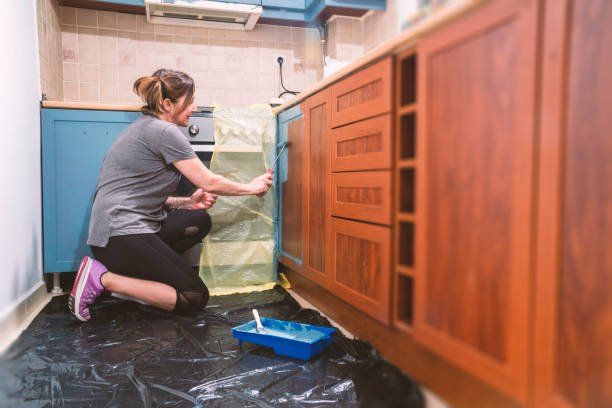How to Hide Wood Filler After Staining in San Francisco: The Best Tips and Tricks
If you're like most people, you probably don't enjoy the process of staining wood. It can be a bit messy and time-consuming. But the end result is always worth it, especially when your project looks great! One thing that can sometimes be a little tricky is hiding the wood filler after staining. In this blog post, we will give you some tips and tricks on how to do just that and also help you find a reputable company in San South Francisco. Let's get started!
What are wood fillers and why do you need to hide it after staining?

Wood filler is a type of putty used to fill in holes, cracks, and other imperfections in wood. While it is not necessary to use wood fillers when staining wood, it can help to create a smoother finish. Wood filler comes in a variety of colors, but it is typically best to choose a shade that closely matches the color of the wood being stained. Once the wood filler has been applied, it should be allowed to dry completely before wood stain. Otherwise, the putty will absorb wood stains, creating an uneven finish. Once the wood filler has dried, it can be sanded down for a smooth surface. Finally, stain can be applied evenly over the entire piece of wood for a professional-looking finish.
How to use wood filler before staining
Depending on the wood you are using, you may want to apply a wood filler before staining. This is especially true for soft woods like pine, which can absorb a lot of stain and appear blotchy as a result. To use wood filler, start by sanding the area to be filled smooth. Next, apply the filler with a putty knife, pressing it into the nail holes, cracks and crevices. Once the filler is dry, sand it down until it is level with the rest of the surface. Finally, wipe away any sanding dust or wood grain before proceeding with the stained wood filler process. By taking these steps, you can ensure that your stain and wood filler will be evenly absorbed and that your finished product will have a professional appearance.
How to hide wood filler after staining - the best tips and tricks
Staining wood is a great way to give it a new lease on life, but it can be tricky to get an even finish. One of the most common problems is having the wood filler show through after staining. Luckily, there are a few simple techniques you can use to prevent this from happening.
One of the most important things to do is to choose the right type of wood filler. For example, if you're using a water-based stain, make sure to choose a water-based wood filler. This will help to ensure that the color is evenly absorbed by the filler. Once you've chosen the right filler, apply it carefully to the area you're trying to cover. Make sure to smooth it out as much as possible so that it blends in with the surrounding wood.
Once you've applied the filler to fill nail holes, wait for it to dry completely before proceeding. Once it's dry, you can proceed with staining as usual. Be sure to apply an even coat of stain and allow it to dry completely before moving on to the next step. By following these simple tips, you can ensure that your wood filler will be well-hidden after staining.
Examples of how to hide wood filler after staining
When it comes to finishing wood, there are a few options for hiding wood filler. One is to use a gel stain or wood glue, which can be applied with a cloth or brush. Gel stains are ideal for filling in small imperfections and will dry quickly, allowing you to move on to the next step in your project. Another option is to use a color-matched putty, which can be applied using a putty knife. Once the putty has dried, you can sand it down until it is flush with the rest of the wood. Finally, you can also use a wood marker to fill in any small gaps or cracks. Simply choose a marker that closely matches the color of your wood and then fill in the imperfections. Once the marker has dried, you can proceed with your chosen finish.
How to find a good painting and wood staining company in San Francisco?
If you're like most people, your home is your biggest investment. And if you're like most homeowners, you want to do everything you can to protect that investment. One of the best ways to do that is to keep your home in good condition - and that includes the exterior. Over time, paint can fade, wood can rot, and siding can become loose. That's why it's important to hire a reputable painting and wood staining company to keep your home looking its best.
There are a few things to look for when choosing a painting and wood staining company. First, check to see if the company is licensed and insured. This will protect you in case of any damage that may occur during the job. Second, ask for references - preferably from customers who have used the company's services within the past year. This will give you an idea of the quality of work you can expect. Finally, be sure to get a written estimate before work begins. This will help avoid any surprises down the road.
If you live in San Francisco, south San Francisco, foster city, Hillsborough, San Mateo, Brisbane, or Redwood City, there are plenty of options when it comes to choosing a painting and wood staining company. But no matter where you live, the tips above will help you find a reputable company that will do a great job on your home.

FAQs
Q: Will wood filler show through after staining?
A: It is possible for wood filler to show through after staining, especially if it is not properly blended into the surrounding area. To avoid this, be sure to use a dried, clean brush to apply an even layer of wood filler. Once the filler is dry, sand it until it is flush with the surface of the wood. Then, apply a thin layer of stain over the entire piece of furniture. Wipe away any excess stain, and allow it to dry completely before adding a topcoat. With proper preparation, you can ensure that your wood filler will be invisible after staining.
Q: Can I use wood filler on stained wood?
A: Yes, you can use wood filler on stained wood. However, you will need to take care to match the color of the filler to the stain. If the colors do not match perfectly, the filler may be visible after staining. For best results, use a light-colored wood filler on darker-stained woods, and a dark-colored filler on lighter-stained woods.
Q: Do I need to seal the wood filler before staining?
A: No, you do not need to seal the wood filler before staining. However, if you are using a water-based stain, it is important to choose a water-based wood filler. This will help to ensure that the color is evenly absorbed by the filler. Once you've chosen the right filler, apply it carefully to the area you're trying to cover. Make sure to smooth it out as much as possible so that it blends in with the surrounding wood. Once you've applied the filler, wait for it to dry completely before proceeding. Once it's dry, you can proceed with staining as usual. Be sure to apply an even coat of stain and allow it to dry completely before moving on to the next step.
As you can see, there are a few different ways to hide wood filler after staining. By choosing the right type of filler and applying it carefully, you can ensure that your woodworking project looks its best. With a little effort, you can make sure that your wood filler is well-hidden and doesn't ruin the look of your finished piece.
For more tips on woodworking, be sure to check out our other blog posts!
You might also like
Book A Service Today



